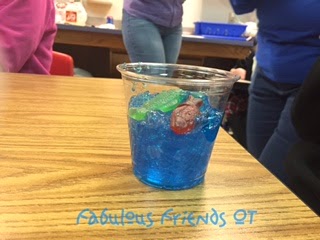Ask any kid in elementary whose birthday it is this week, and they will tell you~ Dr. Seuss!! Who doesn't love Dr. Seuss books?? So, keeping with the theme of Dr. Seuss this week, I have used the following activities (of course you can use them any time, not just for Dr. Seuss week):
Bingo Dabber Dr. Seuss Activity
The triangles could be dabbed white, but we left them. I don't have a white bingo dabber (do they even exist?), but you could use a white shoe polish dabber, or a small sponge square on the end of a clothespin and dip it in white tempera paint.
Cat in the Hat Unifix Cubes
This is just a simple activity that you can use to work on patterning, sequencing and finger strengthening. The kids knew right away that they were making the cubes look like the Cat's hat!
One Fish, Two Fish, Red Fish, Blue Fish Fish Bowls
You will need the following:
- tag board cut out in the form of a fish bowl (I made my own pattern)
- karo syrup
- blue food coloring
- construction paper cut outs of red and blue fish
-Pour some karo syrup on the tag board fish bowl
-Add a drop of food coloring on the syrup
-Have the kids rub the syrup and food coloring on the fish bowl, covering the surface (if they are reluctant to touch it, you could have them wear vinyl disposable gloves or use a paint brush)
-add the red and blue fish cut outs while still wet so that they stick
Jello Fish Bowls
You will need:
- Blue jello
- clear plastic cups
- large spoon for scooping
- Swedish Fish
-Work on scooping and filling and using 2 hands together by having the students hold onto the plastic cup as able and fill it with blue jello
-Top with a couple of Swedish Fish



















